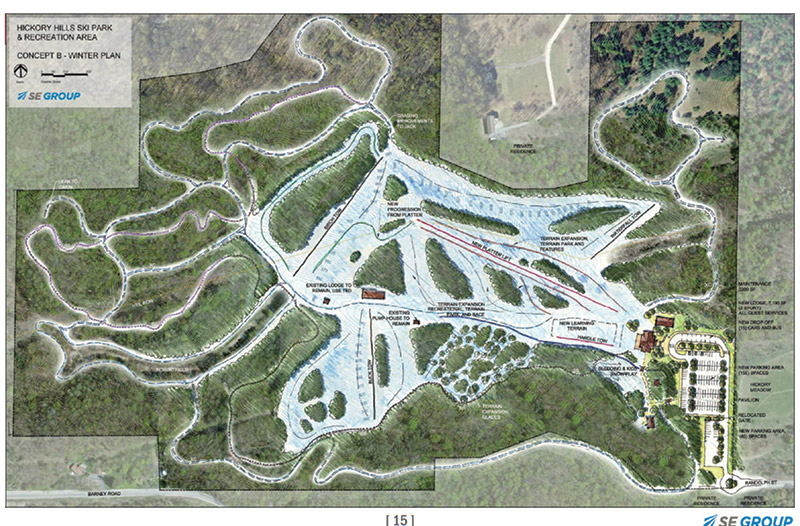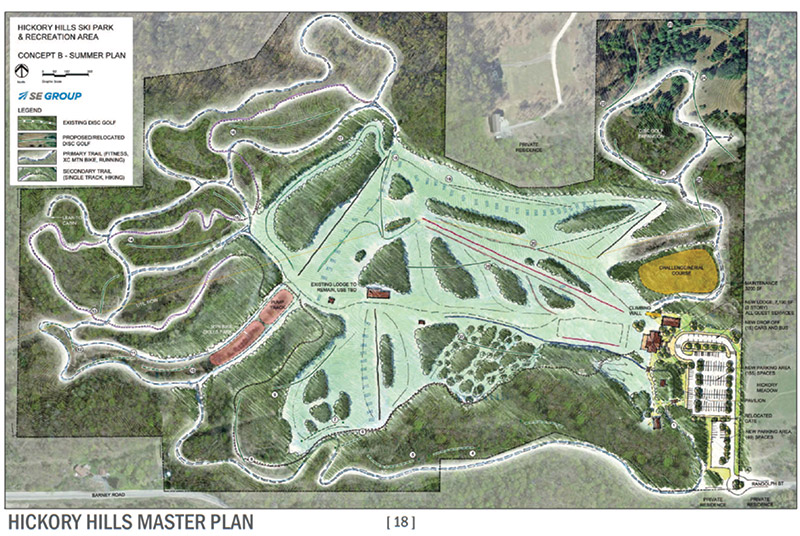THE NEED
 Despite the expanse of the property and significant opportunity for varied recreational opportunities at Hickory, the park’s revenue is currently limited to that generated from its ski operations.2 As such, park operating costs have been viewed by some to be expensive when compared to other parks. To support the ski operations, the City employs full-time and seasonal staff. Annual ticket sale revenues average $90,000 per year representing nearly 93% of revenue for the park. An additional $7,000 is generated through retail, food and beverage sales and lessons. Annual expenses average $175,000. The City funds the remaining ski operating costs through its general fund.
Despite the expanse of the property and significant opportunity for varied recreational opportunities at Hickory, the park’s revenue is currently limited to that generated from its ski operations.2 As such, park operating costs have been viewed by some to be expensive when compared to other parks. To support the ski operations, the City employs full-time and seasonal staff. Annual ticket sale revenues average $90,000 per year representing nearly 93% of revenue for the park. An additional $7,000 is generated through retail, food and beverage sales and lessons. Annual expenses average $175,000. The City funds the remaining ski operating costs through its general fund.
Despite the cost, ski operations are and have been efficiently operated. SE Group, the author of the Plan, concluded that Hickory is “extremely well managed” with operating expenses at only 9-12% of the benchmark comparisons. The consultant’s analysis determined that revenues do not cover expenses because of limited revenue sources. When comparing Hickory to other similarly situated mid-western ski resorts, SE Group determined that Hickory currently experiences only 15% of the benchmark for total revenue per skier visit for two reasons: revenue-producing amenities (food and beverage, lessons, lockers, rental and retail) simply do not exist and the park is closed for most of the year. With the implementation of the Plan, Hickory will draw daily and seasonal users, employ more individuals and produce additional income through all-season fees and food and beverage sales. With greater and all season reach, continued efficient operations and additional revenues, the Plan anticipates that Hickory will no longer operate at a deficit. Plan or not, the public feels so strongly about maintaining the ski hill, however, that 94.3% of survey respondents believe that the City should continue its financial support of the hill. Voter and community support for the hill runs deep.
Facing Hard Facts
Hickory has survived the test of time and yet in many ways is frozen in time. Park lovers are nostalgic for the shed-style lodge,
the fireplace, the hand-hewn ski racks and woodpiles. Hickory, however, must face these facts:
- The infrastructure, especially the 60+ year-old lodge, is ailing
- Operating revenues do not cover operating expenses
- Potential revenue sources exist, but have not been tapped
- The park remains underutilized, especially for all-season recreation
- Current park amenities are not universally accessible and do not meet ADA standards
The Plan resolves these issues and will maximize Hickory’s potential, yet respect its much-loved, natural setting.


 Despite the expanse of the property and significant opportunity for varied recreational opportunities at Hickory, the park’s revenue is currently limited to that generated from its ski operations.2 As such, park operating costs have been viewed by some to be expensive when compared to other parks. To support the ski operations, the City employs full-time and seasonal staff. Annual ticket sale revenues average $90,000 per year representing nearly 93% of revenue for the park. An additional $7,000 is generated through retail, food and beverage sales and lessons. Annual expenses average $175,000. The City funds the remaining ski operating costs through its general fund.
Despite the expanse of the property and significant opportunity for varied recreational opportunities at Hickory, the park’s revenue is currently limited to that generated from its ski operations.2 As such, park operating costs have been viewed by some to be expensive when compared to other parks. To support the ski operations, the City employs full-time and seasonal staff. Annual ticket sale revenues average $90,000 per year representing nearly 93% of revenue for the park. An additional $7,000 is generated through retail, food and beverage sales and lessons. Annual expenses average $175,000. The City funds the remaining ski operating costs through its general fund.
